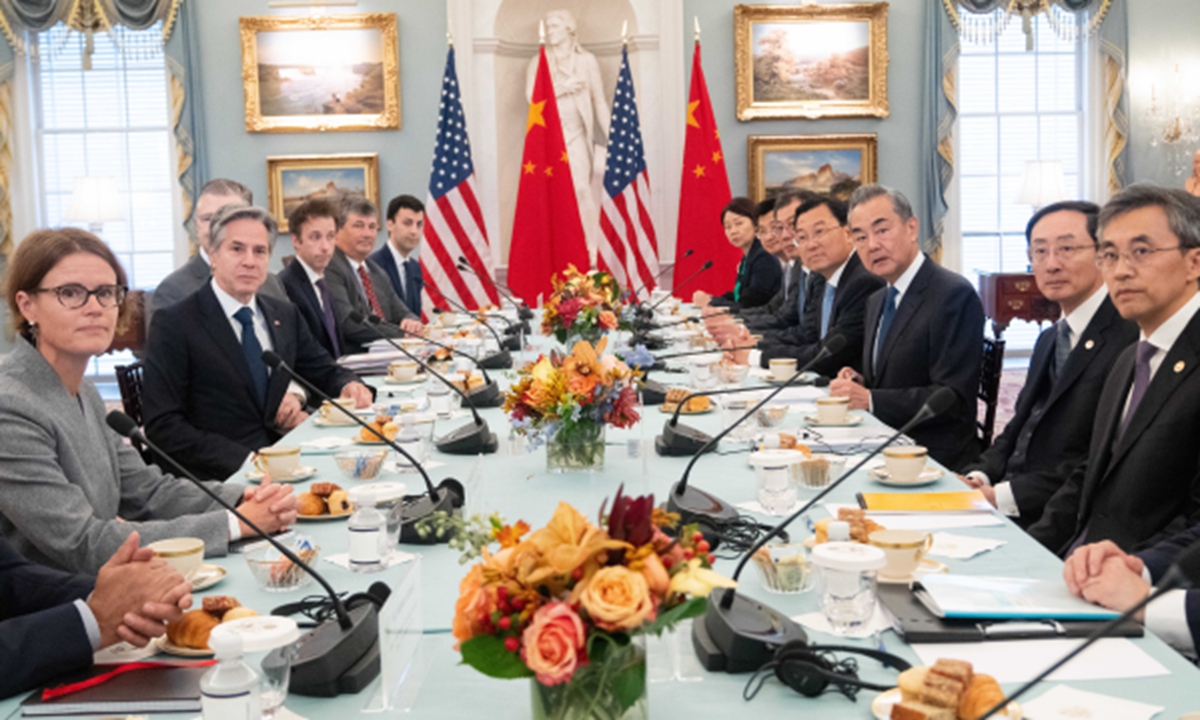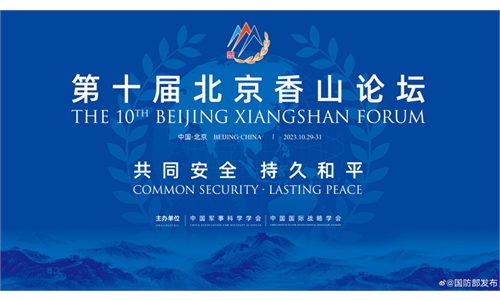The signposts for ‘the path to San Francisco’ are very clear: Global Times editorial

Member of the Political Bureau of the CPC Central Committee and Foreign Minister Wang Yi holds talks with US Secretary of State Antony Blinken in Washington, D.C. Photo: fmprc.gov.cn
Wang Yi, a member of the Political Bureau of the Communist Party of China Central Committee and Chinese Foreign Minister, concluded his visit to the US from October 26 to 28. This is the first dedicated visit by a senior Chinese official to the US since the recent series of successive visits by high-ranking US officials, including the Secretary of State, Treasury Secretary, and Commerce Secretary, to China starting in June this year. People have a prominent feeling about this visit, which is that there are clearly more positive factors in the China-US relationship. In particular, both sides have agreed to make joint efforts toward the realization of the meeting between the heads of state in San Francisco, and the release of this signal has attracted great attention from the international community. Promoting and achieving this goal is obviously beneficial to the interests of both China and the US, and also meets the expectations of the world. This requires China and the US to meet each other halfway. The US side in particular should exclude the interference of its own political agenda and take practical measures and actions.During his three-day visit to Washington, Wang held two rounds of talks with US Secretary of State Antony Blinken, totaling more than 7 hours, and had a discussion with Assistant to the US President for National Security Affairs Jake Sullivan for over an hour. He also had a one-hour meeting with US President Joe Biden at the White House. The topics covered in this series of high-intensity talks were quite extensive, covering almost all hot issues in US-China relations and international affairs. Through these in-depth, constructive, and substantive strategic communications, China and the US have jointly sent positive signals for stabilizing and improving bilateral relations.
The temperature of China-US relations seems to be rising, and many people have such a feeling. While Wang was visiting the US, California Governor Gavin Newsom was also visiting China. He generously praised China's governance and development achievements and said "the more successful China is, the more successful we all will be," receiving a sincere welcome from Chinese society. As an official with relatively fewer domestic political agenda constraints, Newsom can speak relatively freely in China without much political burden. However, we believe that his expressions in China are not deliberately catering to others, but rather heartfelt. This also indirectly reflects the nature of mutually beneficial and win-win relations between China and the US will be more evident when political and ideological interference is excluded. This is actually the normal state of China-US exchanges.
However, China and the US still face many uncertainties in further promoting high-level interactions and stabilizing bilateral relations. Especially whenever there is an opportunity for improvement in China-US relations, one or even several "hidden arrows" will be shot from somewhere within the US, hijacking and undermining China-US relations with absurd political logic. The unexpected "balloon incident" at the beginning of this year is a typical example. Now, China and the US are standing at a new crossroads, and there are increasingly more voices in the US from the business, intellectual, and policy circles calling for a rational view of China. In this context, how to eliminate those "hidden arrows" and integrate into the efforts to stabilize and improve China-US relations as soon as possible tests Washington's political courage and foresight.
Recently, the US side has increased the number of US-China flights to 35 weekly round trips. We welcome this move, but there is still much more that the US side can do. For example, in areas such as economy, trade, and people-to-people exchanges, the US side can cancel the harmful and self-damaging tariffs on China and effectively remove various barriers to people-to-people exchanges between the two countries. These measures are beneficial to both countries and will be welcomed not only in Chinese society but also in American society. In addition, the biggest challenge facing China-US relations is "Taiwan independence." The US side has repeatedly made clear commitments not to support "Taiwan independence." The extent to which these commitments can be translated into specific policies and actions also affects the credibility of the US itself. As Wang pointed out during his visit to the US, the path to San Francisco is not smooth and cannot be left to "autopilot."
San Francisco holds a special significance in the history of China-US exchanges. Whether it is the first pair of sister cities between Shanghai and San Francisco, or various other bilateral collaborations, many bridges of communication, cooperation, friendship, and mutual trust between China and the US have been built from here. We hope that the US side can find the signposts for "the path to San Francisco" and make practical efforts to establish a new starting point for the next stage of meaningful engagements and stable relations between China and the US.



